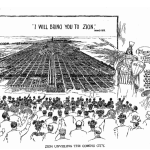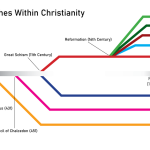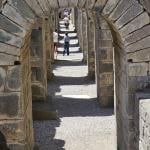At the beginning of each “letter” to the seven churches, Jesus identifies Himself with a descriptive phrase that goes back to the original vision of John in 1:12-20. The churches are judged and evaluated by the ideal human, Jesus. The following lists the connections:
1. Ephesus: stars and lampstands, 1:13, 16, 20
2. Smyrna: first and last, dead and living, 1:18
3. Pergamum: mouth-sword, 1:16
4. Thyatira: eyes and feet, 1:14-15
5. Sardis: stars and spirits, 1:16
6. Philadelphia: key, 1:18
7. Laodicea: Amen, Faithful, True, Witness, Beginning, 1:5, 8
Several of the descriptive phrases in the “letters” structurally match the description of Jesus in a chiastic order:
A. Beginning, end, faithful, 1:5, 8
B. Eyes and feet, 1:14-15
C. Mouth-sword, 1:16
D. Dead and living, 1:18
E. Lampstands and stars, 1:20
E’. Ephesus: stars and lampstands, 2:1
D’. Smyrna: First and last, dead and living, 2:8
C’. Pergamum: mouth-sword, 2:12
B’. Thyatira: eyes like flame and feet like bronze, 2:18
A’. Laodicea: Beginning, faithful, true, 3:14
But this chiastic arrangement doesn’t capture all of the letters. Two of them stand out: Sardis, where Jesus has stars that are spirits, which matches 1:16, and Philadelphia, where Jesus has a key and matches 1:18. Five of the seven letters lay out the description of Jesus in reverse order, but these two letters – numbers 5 and 6 – are stray
One of the effects of this arrangement is to break the seven letters into two groups in a 4 + 3 pattern. The first four are symmetrically arranged with the description of chapter 1, but the last three, while still drawing from chapter 1 in the main, are not structurally symmetrical. That pattern matches the content of the letters. In the first three letters, Jesus finds things to commend in each church (2:2, 9, 13, 19), but Jesus can find nothing good to say about the church at Sardis. The letter is a wake-up alarm and a warning, and a threat that Jesus will come as a thief while the believers in Sardis are still sleeping. Philadelphia is again commended (3:8), but when Jesus gets to Laodicea, there is nothing good to say again – they are merely lukewarm. The smooth pattern of seven letters is broken after the fourth letter. The letter to Sardis disrupts the literary pattern, as the drowsiness of Sardis disrupts the churches.
We can push this a step further by recognizing the importance of the fact that Jesus sends messages to “seven” churches. That is clearly a creation motif. Jesus speaks words of new creation, and those words are written down, so that the sevenfold word of new creation can be spoken to the new creation, the church. But the sevenfold “let there be” is interrupted after the fourth “day.” Jesus is the new creation embodied, and that new creation is supposed to be reflected in the churches. But because of the unfaithfulness of the church, it is not. Jesus is the perfect man, but the ecclesial portrayal of this perfect man is marred by the failures of the churches.
Not only does Sardis break the pattern, but certain features of Jesus are not mentioned in the letters. When John first sees Jesus, He is the complete Lover, and can be described in His glory from head to toe. But the letters do not give us a complete portrait. Jesus has shown Himself completely to John, but does not portray Himself completely to the churches. The image is shattered; in place of the Boticelli portrait of chapter 1, we get a Picasso. In the letters, there is no reference to Jesus as son of Man, no reference to His robe, to His head and hair, to His voice, to His face like the sun. Over the course of Revelation, however, the rest of the picture of Jesus is filled in. Especially in the visions of Jesus in Revelation 10, 14, and 19, the fragmentary picture from the seven churches is gradually filled in. When we finally get to the end of Revelation, Jesus has shown Himself fully not only to John but to the churches. And by the end of Revelation too the new creation has been completed; the glory of Jesus is imprinted on and radiant in the glory of the bridal city.










